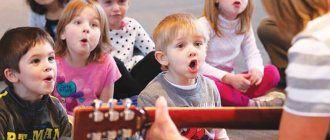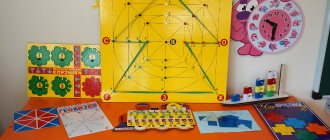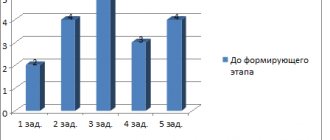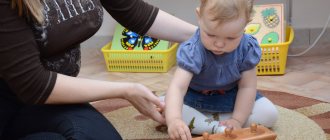Parents who seriously think about the future of their child try to start their education from an early age, using the experience of past teachers who have proven the validity of their views in practice. Nikitin’s methodology, which is aimed at the development and education of children in a playful way, does not lose its relevance.
Goal and tasks
As the Nikitins believed, the key goal of raising a child is the development of a creative personality, and it is on this that the basic principles of the methodology are based. The purpose of the system they developed can be formulated in a similar way.
The objectives of the methodology are:
- harmonious intellectual and physical development of the child from an early age;
- the formation of his independence due to the non-interference of parents in the process of solving a specific problem;
- doing certain exercises helps the child understand colors and basic geometric shapes;
- didactic games are aimed at developing the child’s logic, thinking, and memory in an unobtrusive and easy way.
Many developmental tasks of the Nikitin family appeared during their direct communication with children, with the participation of the latter, and therefore are accessible to children, useful and interesting to them.
A little about the creation of the system by Boris and Elena Nikitin
Boris and Lena Nikitin created the method in the process of raising their own children, of whom there were seven born in the family. Since the system began back in 1957, it is difficult to imagine what kind of public censure its authors had to face, who, despite Soviet principles, raised their children according to their own rules.
Much of what the Nikitins were innovators in does not surprise anyone today: natural childbirth, immediate breastfeeding, feeding on demand. The sight of children running in their underwear in the snow provoked a sea of criticism, even despite the facts that spoke in favor of such upbringing: children’s good health, high level of intelligence, development ahead of their peers for several years. But the Soviet Union was known for the fact that any action that went beyond the norms and boundaries was doomed to condemnation by society, no matter how weighty the arguments were for the person committing it. The authors deserve enormous respect for such innovation alone.
The principle on which the entire methodology is based: do not interfere, but help the child develop.
The Nikitin system includes the early development of a child’s abilities at the intellectual and physical levels
Boris Nikitin put forward the theory that any abilities in a child can be pushed to development if done in time. And he considered the most appropriate time to start classes with a baby not even the infant period, but the perinatal period. According to this theory, human abilities that do not receive an impetus for development at the right time inevitably fade away and cannot be developed in the future.
And if these abilities (intellectual and other) are not activated early, then later they will “die out” - as unnecessary...
B. Nikitin
https://nikitiny.ru/intellektualnoe_razvitie
Developing his idea, the author criticized the public educational system.
At school, not a single teacher would think of assigning a problem without first explaining how to solve it. This means that at school the child will encounter almost no tasks that can advance him in the development of his creative abilities, and he has less and less free time, until by the time he reaches high school there is none left at all.(…)
From the standpoint of the new hypothesis, the fact of the mass “production” of lagging behind and second-year students in orphanages, in orphanages and in “week-long” kindergartens is also completely explainable. Here, good supervision of the child and a particularly firm daily routine are of greatest importance, in which the baby does not need to solve new problems (...)
B. Nikitin
https://nikitiny.ru/NUVERS
Yes, this confirms that an education system built in this way does not accustom a person to the main thing - to learn and learn, to ask questions and find answers to them, but has a detrimental effect on abilities and basic development. As a result, there is not only creative degradation, but also personal degradation.
Factors contributing to early development (according to the system)
The Nikitins believed that natural development is the best option for a child, but in most modern families it is artificially inhibited. In such cases, it is not the needs of the baby that are taken as the basis, but the stereotypical thinking of adults. Parents believe that they know when the baby is supposed to master this or that skill, and they forbid him to perform some actions under the pretext of “it’s too early,” while, on the contrary, they impose others because they are sure that “it’s already time.”
It is still common to encounter parents, and more often grandparents, who panic if a four-month-old baby tries to assume an upright position. According to the norms, a child should sit independently at the age of six months. The Nikitins did not follow this approach, giving children the opportunity to develop ahead of established standards.
The authors of the system identified the following main factors contributing to early development.
- The child is given great freedom of action. There is no compulsion to study as such. Children study and practice as much as they want.
- The physical development of a child is no less important than his education. It is important to have a sports corner, hardening, and no restrictions on playing sports.
- The indispensable participation of adults in children's activities: games, competitions, creative processes. A child needs to feel his parents’ concern for his successes, but at the same time he should not feel pressure and specific requirements for his abilities.
Physical development is as important for a child as intellectual development
Pros and cons of the technique
Despite all the controversial issues that may arise in the process of studying the Nikitin system, practice shows that there are undoubted advantages of it. Even methods such as hardening, which still seems radical to many, give consistent results.
- Children raised according to the Nikitins' method are distinguished by good health and endurance.
- Development occurs much earlier, and the mental abilities of children are not limited by a given program, as can be observed in children raised according to standard principles. A way of thinking is formed that solves problems, both mathematical and everyday.
- Living conditions, everyday life - everything is arranged and distributed in such a way that it is easy for parents and children to fulfill their responsibilities and no one feels overloaded.
History of creation
The system appeared in the second half of the 60s of the twentieth century and immediately attracted everyone’s attention, since the Nikitins’ approach differed significantly from the norms and principles that reigned in Soviet didactics. The first publication by teachers was published in 1962, and later the proposed innovations attracted the interest of specialists abroad - in Germany and Japan.
The Nikitin methods were developed by those people for whom the problem of raising children was relevant, because the spouses Lena Alekseevna and Boris Pavlovich had seven of them. They not only offered other parents to get acquainted with their own experience, but also, being professional teachers, actively used their knowledge. The Nikitin children began studying mathematics and writing at the age of 3-4 years. The couple tried to raise their children in conditions as close to natural as possible, paid great attention to hardening, physical activity, and provided the children with complete freedom of movement from birth.
Nikitins
Boris Pavlovich Nikitin (1916-1999) and Elena Alekseevna Nikitina (1930-) raised seven children according to their own, non-traditional education system (from which the entire village of Bolshevo near Moscow, where the Nikitin family lived, was shocked). People first started talking about them in the late 50s of the 20th century. Boris and Elena are considered Russian innovative teachers; their educational methods are still used today. It was the Nikitins who laid the foundations of parental pedagogy in the 1960-1970s; they were the first to talk about the need for early development.
Advantages and disadvantages
The advantages of the technique include the following.
- This approach allows you to achieve comprehensive physical and intellectual development.
- Helps improve logic, intelligence, spatial thinking, imagination, memory, and the ability to find non-standard paths.
- Teaches kids to be independent, persistent and purposeful from an early age.
- Helps to gain basic knowledge about the most important abstract concepts, which will be useful in the future at school.
It should be noted that the technique is not without its drawbacks.
- Exercises and games are carried out with the interaction of the baby and parents, which, of course, is very useful, but limits the child’s communication with peers.
- The development of a preschooler will not be comprehensive when using only the Nikitins’ methodology, so it should be supplemented with recommendations from other teachers.
- The system is focused on home education, so often children who developed exclusively using this method find themselves unprepared for school life.
- Due to the lack of story-based and role-playing games, the baby does not learn to play; throughout the day he trains his brain, which leads to significant energy expenditure and causes fatigue. Such a child is deprived of many bright moments of childhood.
Let us note that the method has far fewer disadvantages than positive aspects, and they can be easily removed by caring parents who will give their child the opportunity to communicate with peers, play with them the way the child himself wants, and relax.
Principles of the method in raising children under one year old
The goal of the technique, designed for children under one year of age, is to create the most necessary conditions for the child. This age is more characterized by physiological development, which is the basis for further growth of intelligence. The beginning of the implementation of the Nikitin methods is not even infancy, not childbirth, but all the time from the moment of conception.
The physical development of children under one year of age is the basis for their further intellectual growth
Fundamental nuances of development up to one year
- Family atmosphere. Every child should be desired and raised in love and harmony between parents.
- Pregnancy. During this period, certain conditions must be observed: abstinence from nicotine, alcohol and medications, an active lifestyle for the expectant mother, and mandatory communication with the fetus.
- Childbirth. They should take place without the use of medications, preferably at home. Attachment to the breast occurs immediately after birth (even before the placenta comes out).
- Feeding the baby. Until the first tooth erupts, the baby should receive only breast milk and clean water. Feeding occurs on demand. From the very beginning of introducing complementary foods, there is no need to heat food to a certain temperature.
- Contact with mother. From birth to one and a half years, the child should have contact with his mother as often as possible, including the night period (sleeping together).
- Congenital reflexes. In no case should the development of motor reflexes (crawling, grasping, swimming, attempts to sit independently, walk) be prevented, no matter how early they appear.
- An environment conducive to development. Sports equipment is a natural household item. Availability of construction sets, manipulative games, office supplies (paints, pencils, plasticine, etc.) in constant access.
- Freedom in knowledge. Do not limit the child’s movement or crawling. Playpen - maximum for an hour a day.
- Hardening. From birth, after bathing in warm water, it is necessary to pour cool water over either the entire body or just the baby’s legs.
- Sleeping in the air. In any weather, in any frost, daytime sleep should take place in the fresh air.
- Lack of sterility. Cleaning the premises is very basic. No special sterility.
- Hygiene. In addition to standard daily bathing, the Nikitins trained children to use the toilet from birth, sitting them over a basin even at night.
- Lightweight clothing. It should not hinder movements. At home, where the temperature is about +20 degrees, children walk barefoot and in underwear. Infants do not wear hats indoors; their bodies are exposed to air as much as possible. At the same time, open windows are normal.
- Safety precautions. The best way to let a child understand that an object is dangerous is to allow him to come into contact with it. You will not be able to control your baby 24 hours a day and protect him from, for example, spilling boiling water from a kettle on himself. But if the baby touches something hot and gets a slight pain, he will definitely remember the danger.
As you can see, Nikitin’s methods of raising his children under one year old seem cruel and unsafe. Many modern parents cannot imagine that their child can be outside at a temperature of +10 without a warm hat and full winter gear. Of course, you can panic at the sight of a baby licking a rattle that you washed with soap an hour ago, but you can look at the facts. The facts are that in practice, the Nikitin children always had good health and were ahead of their peers in development.
Main principles
The spouses explained their position as follows: their task is to educate not geniuses, but self-sufficient and harmonious individuals, who are characterized by a cognitive beginning, keen interest, the desire to create, and the presence of their own position.
The Nikitins’ technique is based on the “three pillars” - fundamental principles.
- Children need special conditions that promote mental and physical development, so parents should carefully consider the design of the children's room: it should be cozy and comfortable. To help your child learn naturally, you can hang cards with letters, an image of a world map, and number tables on the walls.
- The parent’s task is to offer the child a task, but not to impose an approach to solving it, much less the correct answer. The main thing is that the child must show creativity, only in this case the result will be positive. The Nikitin exercises are structured in such a way that several possible solutions are possible.
- Close interaction between the child and his parents is key in the educational process.
Based on these principles and using the developmental benefits of the Nikitins, parents will be able to help their children grow up as harmonious and gifted individuals who do not experience problems in communication and socialization.
Major works
The spouses Lena and Boris Nikitin have written a large amount of educational literature that can be used by modern parents.
Let's list the most famous benefits:
- “The first lessons of natural education, or Childhood without illnesses.”
- "Our lessons."
- "Are we right?"
- "Mind games".
According to their methodology, the child had to begin his education from an early age, and we are talking not only about physical, but also about mental development. That is why all kinds of sports equipment were placed for children, books and visual aids were freely available. At the same time, no one should limit the child’s choice; only he himself could determine what exactly he would do. In modern life, it is quite difficult to fully adhere to this technique, because it is focused on the constant presence of both the child and his mother at home, but parents can safely use elements of intellectual and educational games that will help prepare the child for school, improve his thinking, imagination, and memory.
How should you raise a child?
The Nikitins emphasized the importance of maintaining physical contact between mother and child for as long as possible. For the full development of a child, the closeness of the mother is as important as various developmental exercises. They recommended putting the baby to the breast immediately after birth, and not taking it away (as was done in the USSR and is sometimes practiced now).
The Nikitins condemned the strict daily routine for a preschooler. After all, a clear routine and compulsory classes can both tire a child and make him dislike classes. They believed that it was necessary to create an environment that would stimulate his desire to learn and explore. Playpens and strollers are a prison for a child, the Nikitins believed.
There are often two extremes of parenting:
- Overorganization or overprotective care, continuous activities and games and lack of time for independent development.
- Abandonment or parents doing the bare minimum (feeding and putting them to sleep), which can lead to mental retardation.
However, there is a third way in raising a child. The child is the master of his actions and routines. A parent is an assistant who will help you understand a complex problem, without forcing or obliging you to do anything.
Best age for classes
Nikitin's complex of educational games can be used for preschoolers of all ages, since by changing the tasks it is easy to increase the level of complexity of the game itself. You can start training with cubes from the age of 1.5 years, this will contribute to the development of fine motor skills. For the little ones, it is enough to use cubes of the same color, simply lay them out, trying to create a “path”. At 3–4 years old, you can safely offer children multi-colored cubes and complicate the task, asking them to put together a pattern.
How to choose Nikitin cubes
Like any other toy, Nikitin’s educational cubes should be chosen based on the child’s wishes. If he liked the wooden blocks, there is no need to force multi-colored cubes or squares on him. When choosing Nikitin cubes, you should take into account the child’s age and the complexity of the game, as well as the child’s psychological and physiological characteristics.
You need to start simple. Even if the task seems elementary to you, let your child set an example: let him feel the taste of victory, and only then move on to a more complex level using task albums.
The game is easy to find for free. You can buy Nikitin cubes in toy stores or order them in online stores. Another option is to buy it on the official website of the Nikitin family with delivery from Moscow or St. Petersburg by mail. The price of Nikitin cubes varies from 350 rubles to 3500 rubles: the exact cost depends on the manufacturer, materials, and size of the set. On the official website it will be more expensive, but of better quality.
Basic benefits
The Nikitin spouses’ method involved the comprehensive development of physical strength and endurance, intelligence and creative potential, and therefore included a large number of benefits.
- The wall bars, jump rope, turnstiles, and balls helped the child train his body.
- Cubes, development boards, and puzzles helped improve logical thinking and creativity.
The constructor is also actively used. Working with the benefits is simple - the child is given a specific task that he must complete.
Mind games
The development of a child’s creativity presupposes the development of his intellect, therefore, in the Nikitin spouses’ method, all kinds of games that are interesting to the child and at the same time useful to him are of great importance. The Nikitins’ method is convenient in that it not only contains theoretical justifications for the rules of working with children, but also offers a set of specific play aids that parents can include in their child’s daily routine. There are many options.
Montessori frames and inserts
This set is intended for children from one year old. It consists of 16 frames and geometric shapes corresponding to them; the child is required to understand which particular shape fits a particular frame and place it “in place.” For the youngest, the task is significantly simplified - they are given the frame itself and a figure (for example, a circle) - the child must understand how to combine them. For children 4-5 years old, you can diversify the exercise - outline both the frames and the inserts, and paint over them.
Unicube
Aimed at developing the child's thinking and attentiveness, it is a set of 27 cubes, the edges of which are painted in different colors. The adult’s task is to give the child a specific task (you can come up with it yourself, for example, build a house out of cubes, stack several cubes so that only the red edges become visible, or look at it in an illustrated instruction book). The educational game will be interesting and useful for children from 1.5 years old. Until the age of three, you can offer the simplest actions, for example, simply placing cubes in a box.
The Nikitins' spouses categorically do not recommend interfering in the process of solving a problem; all that is required from parents is praise for success, and the child must cope with the goal on his own. If adults think that a child is acting “wrongly,” they should still be given creative freedom. There are no wrong decisions, but non-standard ones are quite possible.
Features of educational games for children according to the Nikitins’ method
The help of an adult, a teacher or a parent, is required only at the very beginning, when it is necessary to offer a game to the child, to involve him, to interest him. There is a small psychological moment here - you need to guess the baby’s mood so that it is interesting and comfortable for him to play in a new developmental environment.
- Each game consists of several problems; the child must find a solution using figures, parts, pictures, etc.
- Tasks can be presented in various forms (drawings, drawings, designs, models, etc.), so they stimulate the knowledge of different ways of transmitting information.
- Game tasks should be introduced with increasing difficulty levels.
- Game tasks have a different range of difficulties, from simple ones for 2-3 year olds to complex ones for an adult player. Therefore, Nikitin’s games are interesting at any age.
- The gradual complication of game tasks stimulates the child’s intellectual development, forcing him to think, move forward, and independently develop in creative search.
- An adult should under no circumstances interfere in the child’s play, should not give hints, allowing him to find a solution to the problem situation on his own.
- The child should not be required to immediately solve a game problem. He must reach everything on his own, even if it takes a day, a week, a month.
- The answer to the game task should be visual, tangible, in the form of a diagram, drawing, model, so that the child himself can be convinced that he is right, in his correct choice of solution.
- Educational games should not be limited to the proposed tasks, they can be supplemented, you can come up with your own, new ones, or you can develop more complex or more creative games yourself.
- Intellectual games help you find out the limits of your capabilities.
Thus, the goal of educational games according to the Nikitins’ method is to develop various intellectual qualities in children: memory, attention, spatial imagination, the ability to perform logical calculations, search for patterns, the ability to classify, and find their mistakes. While playing, the child learns to be smart, inventive, and develops creative thinking.
"Fold the pattern"
This game set is deservedly popular. It consists of 16 cubes of the same size, the edges of which are painted in four different colors. There are single-color edges, two-color edges in two variations (fragments of different colors are placed diagonally or in a straight line), 3- and 4-color. The child’s task is to put them together into a pattern; at the initial stage, you can use ready-made options from the instruction book, and then use your imagination and come up with all sorts of combinations yourself. The best age to perform exercises with patterns is from 4 to 8 years.
If necessary, you can create a developmental manual yourself using ordinary wooden cubes and colored paper.
Boris Pavlovich Nikitin proposed to follow the path “from simple to complex” and use the following types and forms of work:
- Children aged 1.5-2 years are best at imitating, so an adult can show an example - build a “path”, turret, train or other simple figure from cubes.
- At 2-4 years old, you can safely start working with flowers, inviting your child to repeat a harmonious pattern previously invented by the parent; it can be either a “path” or a “square”. With each lesson, the patterns themselves should become more complex.
The number of “patterns” folded in one game depends on the child’s abilities and desires. For one, 4-5 different variations will be enough, another child will not calm down until he has collected more than 10. The goal of the parents is not to impose their will, but also not to limit the desire.
- A more complicated version of the game is to fold a pattern based on a finished illustration, but change the colors (for example, on a card the picture is blue and white, but the child needs to fold a red and yellow one).
- As soon as the child begins to assemble such complex variations as “saw”, “flashlight”, “slides” without any problems, you should invite him to copy the resulting pattern from the cubes onto a piece of checkered paper.
- Finally, the most difficult form of work is to come up with a pattern by arranging the cubes in the required order, redraw it and paint over it.
The game “Fold the Pattern” is interesting for children, it helps to develop their intelligence, the ability to analyze and synthesize, the ability to think logically, and combine colors and shapes.
"Fold a square"
The didactic material has three levels of difficulty and is a set of 12 squares, each of which is painted in its own color and intricately cut into pieces. The child’s task is simple - to assemble a whole square; he will be required to select “pieces” of the required color and put them together into the correct shape. You can start working with the simplest version of the “Fold a Square” puzzle from the age of two.
You should act according to the principle “from simple to complex”: first invite the child to assemble a square of three parts, then move on to a more complex option - a square divided into 5 or 6 fragments. Finally, the smartest ones can be offered to create a whole from 7 parts.
Which game according to the Nikitins’ method should be offered to children first?
If educators have several educational, intellectual “Nikitin’s games” at their disposal, then it is advisable to first deal with each of them yourself in order to find out the contents and level of complexity. You can try playing it yourself to evaluate the range of tasks and the time required. Taking into account the age, temperament and character of the child or group of pupils, the easiest game tasks should be introduced first, moving towards more complex ones. For example, if children have become accustomed to the game “Fold the Pattern,” then periodically after a few days the games “Monkeys,” “Montessori Frames,” “Dots,” “Attention,” and others should be introduced.
Educators may be interested in the question: is it possible to keep a group of children occupied by offering them several different games at once using the Nikitins’ method? Boris Nikitin himself claims that this is possible if at least two of the three games have already been mastered and the students are interested. At the same time, it is undesirable to set aside a certain time for gaming activities - 5, 10 minutes, create a time frame and stop. As long as the child is interested and is not reprimanded, let him solve logical problems and complete the task.







